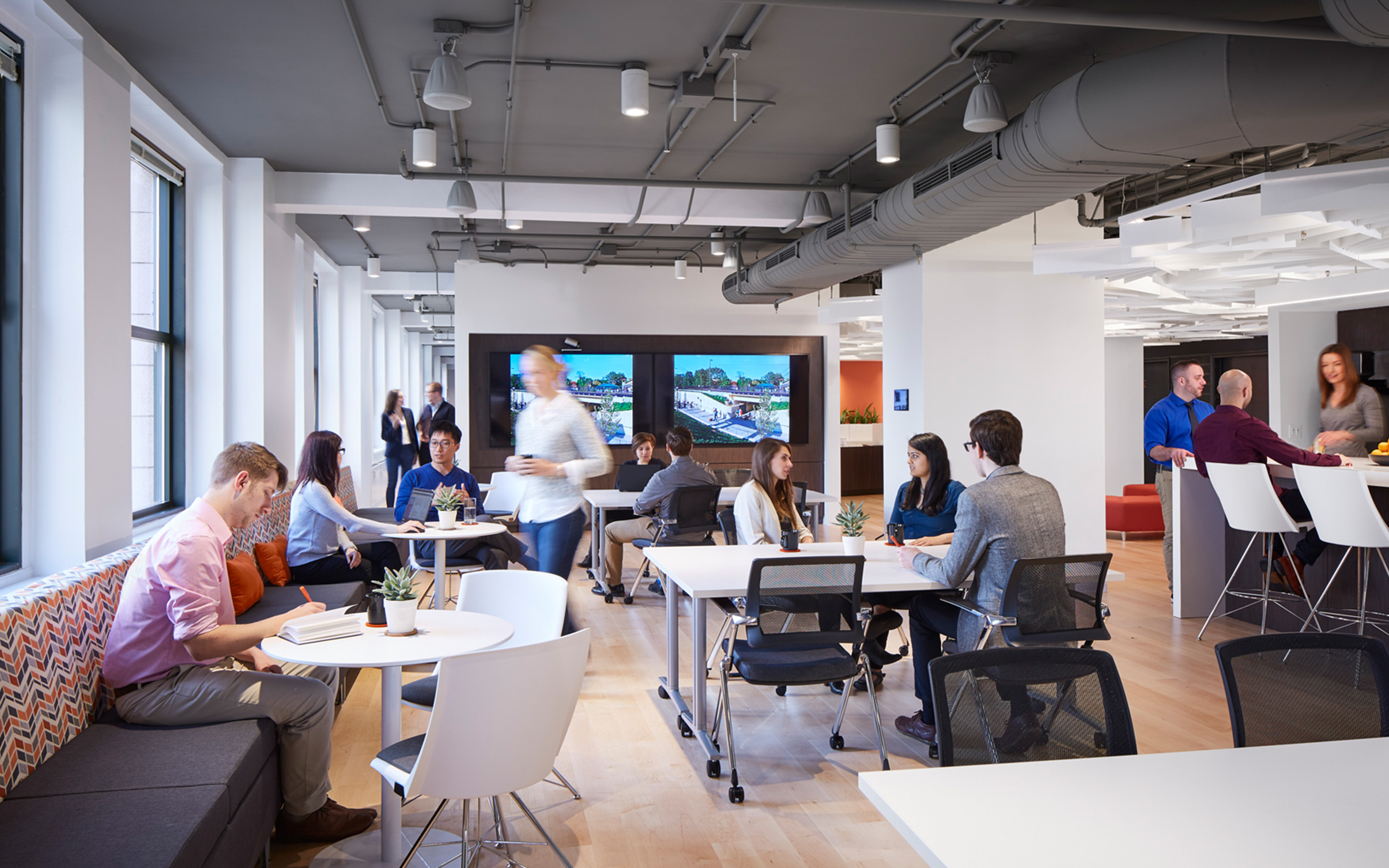Data And Design: Finding The Strategic Needle In An Overwhelming Haystack
This article, authored by Deborah Nemeth & Jen Vogel of SmithGroup, was previously published in Work Design Magazine.
When SmithGroup Chicago moved to a new office, they implemented new technology to evaluate the way space is used – a critical element to the success of an agile environment.
Data collection in the workplace and its impact on designers and end users continues to trend as the next step in understanding the built environment and informing the design process. The methods and types of technology that allow for a seamless collection of data continue to flood the market. Several different methods for data collection were explored tirelessly in the past – visual space observations, online surveys, meeting scheduler data – those methods serve a purpose but do not allow for an accurate, real-time snapshot of space usage.
When SmithGroup designed our new office space in Chicago, we seized an opportunity to exhaustively analyze, critically compare and actionably augment design relative to data feedback. We implemented two different types of data collection systems and area utilization devices into our space. The first system, Enlighted, is a permanently installed advanced lighting control system with a dense array of Bluetooth-enabled sensors distributed across the space. The sensors detect temperature and daylight and allow us to monitor real-time occupancy. Supported by minimal backbone equipment, the sensors and wall controllers transmit data wirelessly. Users can interact with the system through intuitive, floor plan-based software from any networked computer, monitoring energy usage, temperature, trends, and reconfiguration of lighting controls. The system provides its own analysis maps of space utilization and movement, allowing us to capture how employees use the new workspace.
The second system, bluvision, tracks the position of individual employees in near real-time. Using a series of badges assigned to each employee and receivers that plug into standard receptacles, the system uses Bluetooth signals to resolve badge location within a two-meter radius. The signals are collected for each badge every second and stream to cloud storage where they are processed and then stored for later analysis. Unlike Enlighted, bluvision is a highly flexible hardware system that allows for maximum customization of data collection which can be implemented then modified/adjusted as needed. As a part of an Indoor Positioning Study (IPS) to explore how Internet of Things (IoT) technology can augment our ability to monitor workspace activity, the SmithGroup team utilized this flexible system in our space for a period of five months. During that time, we captured more than 300 million data points from over 114 employees. The study was both an exploratory examination of IoT location technology as well as a descriptive analysis of how employees occupy space in the Chicago office.
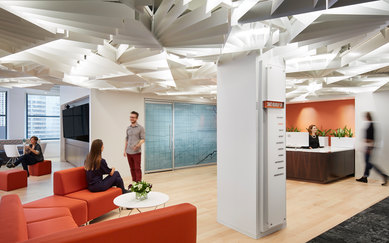
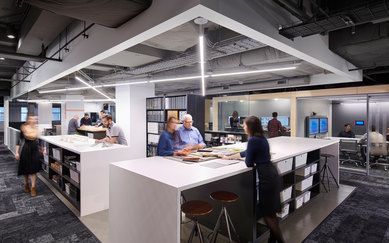
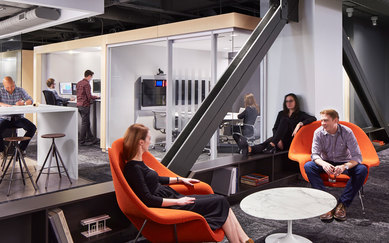

The ability to capture this type of data for our office is critical in evaluating how our workspace is functioning. To support our growing interdisciplinary, multi-generational and multi-market teams, the office transitioned both physically and organizationally into an agile work environment, when we moved into our new space in October 2016. Business drivers defined in initial strategy workshops set out to inspire collaboration within disciplines, break down silos between disciplines and increase engagement among staff. The first of SmithGroup’s fifteen locations to pilot an agile workspace, our Chicago employees have the flexibility to select the space and typology that best suits their various individual tasks, team work and collaboration throughout the day. A wide range of typologies allow for team-based work, social interaction, informal touchdown, focus work, and collaboration. For tasks requiring more focus, a quiet zone, wellness room, and phone rooms were incorporated into the typology mix. Employees may choose from sit-to-stand desks with ample daylighting, bench-style workstation seating with movable pin-up ideation boards, conference and huddle rooms, inviting nooks with great city views, and teaming areas with a variety of reconfigurable furniture. A centrally located maker space provides hands-on experiences for enhanced design visualization including 3D-printing and virtual reality technology. A spacious lobby and café provide further options for breakout, large group activities and industry or community events.
SmithGroup chose to implement these technology in our space for several reasons. Understanding and being able to evaluate the way our space is functioning is critical to the success of the agile environment. The data collection allows us to test, analyze and adjust the way the agile office operates both physically and operationally. Our office space acts as a living, learning laboratory. Internally, to test how Internet of Things (IoT) technology can guide our practitioners when planning interior spaces. And externally, to share our findings with clients and guide them through an informed planning and design process of their own. We want to talk the talk and walk the walk.
As a sustainable organization, the implementation of Enlighted as our advanced lighting control system, allows us to monitor and adjust energy usage and temperature. We also have a unique opportunity for utilizing the data collected. Although we occupy the whole floor, we have only built out three quarters of the floor plate. The build out of the remaining one third of space will be informed by the data we are currently collecting and analyzing.
The ongoing nature of the data collection allows us to continue to evolve the workspaces. During our initial evaluation six months post move in, the data captured simultaneously from Enlighted and bluvision allowed us to uncover what spaces had low utilization rates. We determined the phone rooms and quiet zone both had less than ideal capacity. On average, phone rooms were 25% utilized whereas larger conference and huddle rooms were closer to 47% utilized. After this initial discovery using the floor-plan based software for analysis, we issued an online survey to staff to dive deeper into the key issues effecting usage. We asked employees about both space types, the phone rooms and quiet zone, outlining some possible reasons for low utilization. Survey responses revealed both physical space and organizational adjustments were necessary to increase their usage. Phone rooms lacked the necessary acoustic treatments to fully support their intended use while thermal comfort issues kept many employees from using the quiet zone.
Organizational issues revealed several employees who used the quiet zone were not using it for its intended purpose, thus creating distractions and discouraging others from working there. Armed with a well-informed analysis of the specific reasonings for underutilization, we addressed the staff with an augmented organizational framework. We also addressed the physical issues hindering usage by installing acoustical panels in the phone rooms and adjusting the mechanical system in the quite zone. As a result, utilization has increased in both spaces; phone room usage has increased an impressive 88% and quiet zone usage has increased 33%.
The data also revealed the spaces with high utilization rates. Sit-to-stand desks were by far the most frequently occupied at 87% utilization. Comparing the utilization rate of sit-to-stand desks to bench-style workstations advised us to increase the ratio from the current 1:8 to 1:5 in the future build out of the phase two space. The agile environment also results in higher average occupancy rates. In the previous office space, where employees were assigned workstations, workstations had an average occupancy rate of 66% whereas in our new office space the rate has increased to 94%.
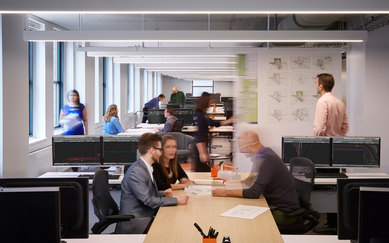
The data we captured with bluvision, during our Indoor Positioning Study, and through our advanced lighting control system, Enlighted, allows us to learn from our how our agile space is truly functioning. The office is currently operating at 118% employees to workstations (100 people to 85 workstations) and this seems to be a sweet spot. We have determined 94% utilization of the overall space, while not 100%, is optimal for the agile environment. At 94% utilization, five workstations remain unclaimed still allowing enough choice and flexibility for employees. Because of the greater ratio of employees to workstations, we can provide 20% more square feet per workstation, giving each employee more space, while working in an office that is 88% square feet per employee by corporate standards. Furthermore, the new environment is also breaking down silos and increasing interaction among staff, one of our key business drivers. Based on the data, all disciplines sit in all zones within the space and no singular age group is more agile than another. Over the course of one month, a workstation zone with 10 desks had more than 41 individual employees flex in and out of that zone. Of the 41 individual employees, only one within the zone sat there every day of the week.
The incorporation of data into our design process allows SmithGroup to make informed decisions not only about our physical space but also the organizational framework contributing to the agile office success. We will continue to collect and analyze data to influence the evolution of our office and to inform typologies for the build out of our phase two space in the future. As a living, learning, laboratory our data collection improves the function of our office space and, most importantly, arms SmithGroup with experience and the knowledge base to guide clients through an informed planning and design process of their own.
